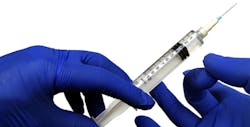Risk vs. Reward: The pressure to reduce expenses in organizations could compromise patient safety when selecting a product based on price alone. This article details the evidence that should be evaluated when determining which prefilled saline flush syringe best meets your patients’ needs and reduces risk for your institution.
Introduction
Millions of prefilled flush syringes (PFS) are used in hospitals and offer safety benefits over manually-prepared flush syringes1 by reducing occlusions,2 extravasation and phlebitis,3 and complications, including catheter-related bloodstream infections (CRBSI)4, and needlestick injuries.5 These are important advantages and have made PFS a standard commodity for hospitals.
Prefilled Flush Syringes are perceived as low-risk, low-liability devices, and procurement departments may place orders or change suppliers for PFS based on device cost alone, assuming that all prefilled saline syringes are the same, that is, sterile and safe. Unfortunately, this assumption is tragically false. A contaminated PFS can inject contaminants directly into the bloodstream, potentially producing significant morbidity and mortality.6
Risks to patients
Problems with PFS are not an isolated occurrence. There have been recalls of PFS every year since their introduction; some have caused drastic patient harm. In 2008, 60 cases of bacterial infections occurred from one source of contaminated syringes,resulting in spinal meningitis and permanent brain damage for some and 4 of those infected died.6 This year, a Class 1 Recall of PFS was initiated following reports of 164 cases of Burkholderia cepacia bloodstream infections across five states and 59 healthcare facilities. Seven of the infected patients died.7
Liability
PFS suppliers are legally accountable for quality issues and may face stiff penalties for patient harm. In a recent case, the U.S. Justice Department ruled that “Companies must take reasonable steps to ensure that their suppliers are making quality products that help rather than harm patients.” Some manufacturers have paid millions of dollars in penalties and have been held criminally liable for selling contaminated PFS that caused patient harm.8
The need for value-analysis
Given these risks and potential liabilities, it is essential that purchasing departments do not make PFS purchasing decisions in isolation or on cost alone. It is critical that a multidisciplinary value-analysis team review the evidence on prefilled flush syringe safety to protect patients and the institution. Some of the key criteria for PFS safety are described below:
Recalls
The selection of PFS should include an analysis of the severity and the frequency of recalls in the context of the volume of PFS manufactured. In the decade from 2006 to 2016, there were three Class 1 recalls where quality issues such as lack of sterility or bacterial contamination led to patient deaths. There were eight additional Class 2 recalls where potential problems were identified before affecting patients. Some recall examples include the presence of particulate matter, lack of sterilization, or actual bacterial contamination in a sealed product, which have a high probability of causing harm. There have been product recalls for PFS nearly every year since their introduction to the market.9,10
Supply continuity
A key variable in supply continuity is the manufacturer’s ability to provide consistent PFS quantities through regular channels of distribution. Disruption in the supply of prefilled flush syringes may interfere with patient care. Current shortages in saline, for example, will impact those PFS suppliers who depend on outsourced saline for their products.11 Some companies ensure a safe, continuous supply of PFS by building redundant production facilities around the world. There are substantial differences in manufacturing volume across PFS sources.
Manufacturing matters
Vertical integration occurs when a company has control over all of the steps involved in the making of its product. From raw materials to formulation, filling, sterilization, inspection, and packaging, an automated, end-to-end, sterile, closed-system manufacturing process eliminates the human touch, reducing potentially life-threatening contamination, and ensuring PFS safety. On the other hand, an open process allows many human touch points where contamination may occur, either from the environment or human contact.
Quality controls inspection
Ideally there is 100 percent inspection of every syringe by fully automated systems to detect visible particulate, closure integrity, proper assembly, fill volume, and other cosmetic defects. The manual inspection process used by some PFS manufacturers is subject to all the risks inherent when humans are responsible for exact performance of a complex task.12
Sterility assurance
PFS manufacturers may use a variety of ways to ensure the PFS is sterile, such as aseptic filling, filtration, irradiation, or steam sterilization. The goal is for the fluid path to be sterile from rubber stopper to tip cap. Steam sterilization provides a Sterility Assurance Level (SAL) at the highest level of sterility (10-6). SAL cannot be determined for chemical or radiation methods of sterilization.13
Take a multidisciplinary approach to pfs safety
A multidisciplinary value-analysis team is best positioned to review the evidence described here to select the optimal source for prefilled flush syringes. An effective value-analysis team would include: Pharmacists, Physicians, Nursing, Risk Management, Infection Control. The checklist up on the right summarizes the key criteria and can be used to assess PFS for your organization.
UNK = unknown.
M = million.
Source for Annual volume: GHX Market Data – Ending Q3FY17.
Conclusion
The criteria presented in Table 1, can assist the value-analysis team to perform the due diligence and get the evidence required to make an informed selection of safe prefilled flush syringes. Don’t let a prefilled flush syringe be the weakest link in the protective chain of intravenous safety.
References
- Sanborn M, Moody ML, Harder KA, et al. Second Consensus Development Conference on the Safety of Intravenous Drug Delivery Systems—2008. Am J Health-Syst Pharm. 2009; 66:185-92
- Schreiber S, et al. Normal saline flushes performed once daily maintain peripheral intravenous catheter patency: a randomized controlled trial. Arch Dis Child. 2015;0:1–4.
- Keogh, S., Marsh, N., Higgins, N., Davies, K. and Rickard, C. (2014) Time and Motion Study of Peripheral Venous Catheter Flushing Practice Using Manually Prepared and Prefilled Flush Syringes. J Infusion Nurs.2014; 37:96–101.
- Bertoglio S, et al. Pre-filled normal saline syringes to reduce totally implantable venous access device-associated bloodstream infection: a single institution pilot study. J Hospital Infection. 2013; 84:85e88.
- Makwana S, et al. Prefilled syringes: An innovation in parenteral packaging. Int J Pharm Investig. 2011; 1: 200–206.
- Jewett C, Shelton D. Dirty syringes: FDA failed to shut down troubled plant, and family paid price. Accessed: 19 October 2017.
- US Centers for Disease Control and Prevention. Multistate Outbreak of Burkholderia cepacia Bloodstream Infections Associated with Contaminated Prefilled Saline Flush Syringes. Available at: https://www.cdc.gov/hai/outbreaks/b-cepacia-saline-flush/index.html. Accessed: 6 October 2017.
- US department of Justice. B. Braun Medical Inc. Agrees to Resolve Criminal Liability Relating to its Sale of Contaminated Syringes. Available at: https://www.justice.gov/opa/pr/b-braun-medical-inc-agrees-resolve-criminal-liability-relating-its-sale-contaminated-syringes. Accessed: 6 October 2017.
- US Food and Drug Administration. Medical Device Recalls. Available at: https://www.accessdata.fda.gov/scripts/cdrh/cfdocs/cfRES/res.cfm?start_search=1&event_id=&productdescription
txt=&productcode=NGT&IVDProducts=&rootCauseText=&recallstatus=¢erclassificationtypetext=&recallnumber=
&postdatefrom=&postdateto=&productshortreasontxt=&firmlegalnam=&PMA_510K_Num=&pnumber=&knumber=&PAGENUM=50. Accessed: 19 October 2017. - US Food and Drug Administration. Medical Device Recalls. Available at: https://www.accessdata.fda.gov/scripts/cdrh/cfdocs/cfRes/res.cfm?start_search=1&event_id=46182&productdescription
txt=&productcode=&IVDProducts=&rootCauseText=&recallstatus=¢erclassificationtypetext=&recallnumber=&postdatefrom=
&postdateto=&prodh. Accessed: 19 October 2017. - US Food and Drug Administration. Statement by B. Braun. Available at: https://www.fda.gov/downloads/Drugs/DrugSafety/DrugShortages/UCM573631.pdf. Accessed: 17 November 2017.
- Jewett C, Nguyen D. Timeline: How Contaminated Syringes Got From Factory to Patients. Source: www.propublica.org/article/timeline-am2pat. Accessed: 18 October 2017.
- von Woedtke T, Kramer A. The limits of sterility assurance. GMS Krankenhaushygiene Interdisziplinär. 2008;3:1-10.

